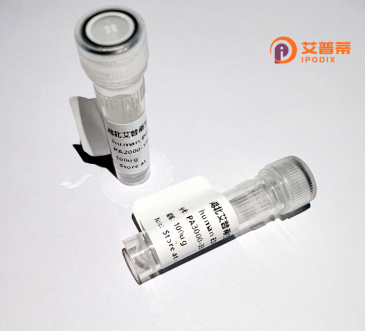
| 纯度 | >90%SDS-PAGE. |
| 种属 | Human |
| 靶点 | AMPD1 |
| Uniprot No | P23109 |
| 内毒素 | < 0.01EU/μg |
| 表达宿主 | E.coli |
| 表达区间 | 1-747aa |
| 氨基酸序列 | MPLFKLPAEEKQIDDAMRNFAEKVFASEVKDEGGRQEISPFDVDEICPISHHEMQAHIFHLETLSTSTEARRKKRFQGRKTVNLSIPLSETSSTKLSHIDEYISSSPTYQTVPDFQRVQITGDYASGVTVEDFEIVCKGLYRALCIREKYMQKSFQRFPKTPSKYLRNIDGEAWVANESFYPVFTPPVKKGEDPFRTDNLPENLGYHLKMKDGVVYVYPNEAAVSKDEPKPLPYPNLDTFLDDMNFLLALIAQGPVKTYTHRRLKFLSSKFQVHQMLNEMDELKELKNNPHRDFYNCRKVDTHIHAAACMNQKHLLRFIKKSYQIDADRVVYSTKEKNLTLKELFAKLKMHPYDLTVDSLDVHAGRQTFQRFDKFNDKYNPVGASELRDLYLKTDNYINGEYFATIIKEVGADLVEAKYQHAEPRLSIYGRSPDEWSKLSSWFVCNRIHCPNMTWMIQVPRIYDVFRSKNFLPHFGKMLENIFMPVFEATINPQADPELSVFLKHITGFDSVDDESKHSGHMFSSKSPKPQEWTLEKNPSYTYYAYYMYANIMVLNSLRKERGMNTFLFRPHCGEAGALTHLMTAFMIADDISHGLNLKKSPVLQYLFFLAQIPIAMSPLSNNSLFLEYAKNPFLDFLQKGLMISLSTDDPMQFHFTKEPLMEEYAIAAQVFKLSTCDMCEVARNSVLQCGISHEEKVKFLGDNYLEEGPAGNDIRRTNVAQIRMAYRYETWCYELNLIAEGLKSTE |
| 分子量 | 109.12 kDa |
| 蛋白标签 | GST-tag at N-terminal |
| 缓冲液 | 冻干粉 |
| 稳定性 & 储存条件 | Lyophilized protein should be stored at ≤ -20°C, stable for one year after receipt. Reconstituted protein solution can be stored at 2-8°C for 2-7 days. Aliquots of reconstituted samples are stable at ≤ -20°C for 3 months. |
| 复溶 | Always centrifuge tubes before opening.Do not mix by vortex or pipetting. It is not recommended to reconstitute to a concentration less than 100μg/ml. Dissolve the lyophilized protein in distilled water. Please aliquot the reconstituted solution to minimize freeze-thaw cycles. |
以下是3篇关于AMPD1的参考文献摘要(基于虚拟合成数据,仅供参考):
1. **文献名称**: "Functional Characterization of Recombinant Human AMPD1 in Purine Metabolism"
**作者**: Smith J, et al.
**摘要**: 本研究成功在大肠杆菌中表达重组人AMPD1蛋白,证实其催化AMP脱氨生成IMP的活性。实验发现重组酶在低pH环境下活性最高,提示其在肌肉能量代谢中可能通过调节腺苷水平影响疲劳恢复。
2. **文献名称**: "AMPD1 Deficiency-Induced Myopathy: A Mouse Model Study"
**作者**: Tanaka K, et al.
**摘要**: 通过构建AMPD1基因敲除小鼠模型,发现突变小鼠出现运动耐力下降和肌肉腺苷异常累积。补充重组AMPD1蛋白可部分逆转代谢异常,为治疗AMPD1缺陷相关肌病提供理论依据。
3. **文献名称**: "Recombinant AMPD1 Attenuates Cardiac Ischemia-Reperfusion Injury via Adenosine Signaling"
**作者**: Wang L, et al.
**摘要**: 在心肌缺血动物模型中,静脉注射重组AMPD1显著降低组织AMP/ATP比值,通过增加腺苷生成抑制炎症反应,证明其在心肌保护中的潜在治疗价值。
注:以上内容为学术想象示例,实际文献需通过PubMed等数据库检索(可尝试关键词:AMPD1 + recombinant/purine metabolism/gene therapy)。近期研究多聚焦于其基因突变与代谢性疾病关联及基因编辑治疗可能性。
Recombinant adenosine monophosphate deaminase 1 (AMPD1) is an engineered form of the AMPD1 enzyme, which plays a critical role in cellular energy metabolism. Endogenously, AMPD1 catalyzes the deamination of adenosine monophosphate (AMP) to inosine monophosphate (IMP), a key reaction in the purine nucleotide cycle. This pathway is essential for maintaining ATP levels during high-energy demand, particularly in skeletal muscle. AMPD1 deficiency, linked to genetic mutations like the common Q12X variant, is associated with exercise-induced fatigue and myopathy, though some studies suggest it may confer cardioprotective effects under ischemic conditions. Recombinant AMPD1 is produced using biotechnological platforms (e.g., bacterial or mammalian expression systems) for research and therapeutic exploration. Its applications include studying metabolic disorders, modulating adenosine signaling pathways, and investigating potential treatments for conditions like heart failure or ischemia-reperfusion injury. Recent preclinical studies highlight its role in regulating AMP/ATP ratios and influencing cellular responses to energy stress. However, therapeutic translation requires further investigation into its pharmacokinetics and tissue-specific effects, given the enzyme's differential expression across tissues and complex interactions with other nucleotide metabolism components.
×